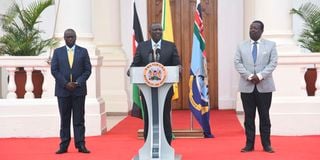Premium
Ruto, Gachagua spend Sh9 billion in seven months, asks parliament for more

Deputy President Rigathi Gachagua (left), President Dr William Ruto and Prime Cabinet Secretary Musalia Mudavadi at State House in Nairobi on September 27, 2022.
President William Ruto and Deputy President Rigathi Gachagua have burst their full-year budget in seven months, official data show, amid austerity plans aimed at reversing a past trend of borrowing to fund government operations.
The latest data published by Treasury Cabinet Secretary Njuguna Ndung’u indicate that the Executive Office of the President spent Sh9.09 billion in the period through January against an original full-year estimate of Sh8.64 billion.
That represents an over-expenditure of Sh450.11 million or 5.21 percent of the original 12-month budget for the Presidency prepared by the previous administration.
The additional expenditure has already been tabled in the House via a supplementary budget under the law that requires MPs to approve spending that lacked a parliamentary nod within two months.
Under the mini-budget, Prof Ndung’u has proposed to increase the budget for the Executive Office of the President by Sh5.18 billion to Sh13.83 billion compared with the original estimates, a growth of 59.89 percent.
State House’s budget has more than doubled to Sh8.85 billion from Sh4.37 billion approved under former President Uhuru Kenyatta, while Mr Gachagua’s office expenditure has been increased by Sh914.25 million to Sh2.63 billion.
The Deputy President has also been added a separate budget of Sh450.85 million outside the Presidency, according to the supplementary estimates before the House.
The over-expenditure by the Office of the President came in the period Dr Ruto, who took power last September, directed the Treasury to cut the budget for running the government by as much as Sh300 billion in measures aimed at bringing “our country to sanity” where the State does not borrow to “finance recurrent expenditure”.
Dr Ruto also said he aimed to bring the recurrent expenditure down further next year by an undisclosed amount, in a bid to achieve a recurrent budget surplus by the third year.
Recurrent expenditure usually includes civil servants’ salaries, travel and refreshment as well as fuel costs for the government’s fleet of vehicles.
The Treasury data show the recurrent expenditure by the Presidency for the seven-month period was 12.47 percent, or Sh931 million, more than Sh7.47 billion spent by the previous administration a year ago.
The biggest jump in recurrent expenditure for the country’s most powerful office was in December when some Sh2.19 billion was withdrawn from the exchequer against a monthly average for the period of Sh1.2 billion.
The new administration’s fiscal consolidation plan has faced hurdles emanating from below-target performance in revenue mobilisation and above-target expenditures.
For example, ordinary revenue— comprising taxes, levies, rent of buildings, investment, fines and forfeitures— for the half year to December fell short of the Sh532.37 billion target by Sh32.81 billion, while recurrent expenditure overshot the budget by Sh114.24 billion to nearly Sh1.10 trillion.
“Recurrent expenditure for national government amounted to Sh1,096.3 billion (excluding Sh25.2 billion for Parliament and Judiciary), against a target of Sh982.0 billion which was Sh114.3 billion above the set target,” the Treasury wrote in the quarterly budgetary and expenditure report for the period ending December.
“The over-expenditure in the recurrent category was mainly due to higher than targeted operations and maintenance expenditures [which were Sh129.52 billion above Sh302.51 billion].”
Prof Ndung’u late last year told the International Monetary Fund (IMF) that the Ruto government was facing intensifying spending pressure coming from Sh279.26 billion non-debt payments which were either carried over from the previous financial year ended June 2022 or unbudgeted like the Sh20 billion Hustler Fund.





